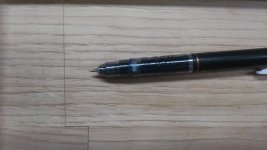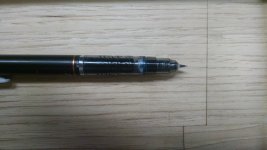I've been working on some jigs to do a Greene and Greene style piece and have been trying to get the jigs as good as possible prior to cutting into the workpieces.
One jig is to help lay out and chisel a haunched miter joint. I had tested the fit a number of times and it seemed all was well, but upon trying the jig, I noticed that the walls of the test piece were sloping outwards, forcing a gap in the face of the joint. Upon close inspection, I found that the entire jig is slightly off square from the face. I had to hold the square and jig up to close light source to see it, but it's there. The error is magnified when the joint is assembled, as the two parts push away from each other, forming what amounts to a small V groove in the joint.
The root cause of the issue, as it tuned out, was that my shooting board had some debris under it, and it was enough to slightly tilt the faces of the mitered pieces as I planed them (I run my plane on the bench). On one side, they looked relatively tight. On the other, apparently it was more of a gap. I should have checked both sides!
Testing the jig itself, I'm seeing a other issues (e.g. slight curvature to the shoulders of the joint) as well. I've attached photos of the front and back of the jig, with a .5mm pencil tip for scale.
At this point, I am asking myself a couple things
1) Is this close enough and should I just fix it by fine tuning/undercutting the joint on the workpiece? Or, I could sand a piece of veneer and glue it into the gap (the real workpiece will have a short grain to long grain joint at the miter).
2) Will this error be magnified even further?
3) Should I try to tune up the jig using files to correct for the out of squareness (in its current state, it would be impossible to use any of the planes I own.. I would need a chisel plane)? Or would this be fussy and probably result in chasing my tail attempting to get it square, flat and perfectly mated to it's opposite part?
4) Should I just remake the jig?
I'm curious to know what some of you think and if you have any ideas on how to correct the jig itself. I used 1" thick hickory and am not relishing the thought of milling up some more of it to make a new jig.
I've been pondering the question of precision/accuracy a lot lately. Probably because I got a very nice square as a gift. At what point do we say 'that's good' when we are working on something? I've been checking for square by holding my pieces up to a light source but they are almost never truly square all the way across - there's always some light peeking through yet without a direct light source behind the piece, the blade appears to be lying dead across the piece. Woods like ash/oak also leak light underneath the blade through the pores, which can further confuse things.
Where do other folks decide to stop?
One jig is to help lay out and chisel a haunched miter joint. I had tested the fit a number of times and it seemed all was well, but upon trying the jig, I noticed that the walls of the test piece were sloping outwards, forcing a gap in the face of the joint. Upon close inspection, I found that the entire jig is slightly off square from the face. I had to hold the square and jig up to close light source to see it, but it's there. The error is magnified when the joint is assembled, as the two parts push away from each other, forming what amounts to a small V groove in the joint.
The root cause of the issue, as it tuned out, was that my shooting board had some debris under it, and it was enough to slightly tilt the faces of the mitered pieces as I planed them (I run my plane on the bench). On one side, they looked relatively tight. On the other, apparently it was more of a gap. I should have checked both sides!
Testing the jig itself, I'm seeing a other issues (e.g. slight curvature to the shoulders of the joint) as well. I've attached photos of the front and back of the jig, with a .5mm pencil tip for scale.
At this point, I am asking myself a couple things
1) Is this close enough and should I just fix it by fine tuning/undercutting the joint on the workpiece? Or, I could sand a piece of veneer and glue it into the gap (the real workpiece will have a short grain to long grain joint at the miter).
2) Will this error be magnified even further?
3) Should I try to tune up the jig using files to correct for the out of squareness (in its current state, it would be impossible to use any of the planes I own.. I would need a chisel plane)? Or would this be fussy and probably result in chasing my tail attempting to get it square, flat and perfectly mated to it's opposite part?
4) Should I just remake the jig?
I'm curious to know what some of you think and if you have any ideas on how to correct the jig itself. I used 1" thick hickory and am not relishing the thought of milling up some more of it to make a new jig.
I've been pondering the question of precision/accuracy a lot lately. Probably because I got a very nice square as a gift. At what point do we say 'that's good' when we are working on something? I've been checking for square by holding my pieces up to a light source but they are almost never truly square all the way across - there's always some light peeking through yet without a direct light source behind the piece, the blade appears to be lying dead across the piece. Woods like ash/oak also leak light underneath the blade through the pores, which can further confuse things.
Where do other folks decide to stop?


